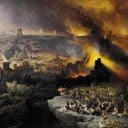Now that we have dealt with the issues surrounding the dating of the book of Revelation our attention will be turned toward the themes and characteristics found in the book itself. Rather than diving headlong into a difficult book filled with imagery, symbolism, visions and unusual language, it serves the reader to try and grasp the main themes explored and the stylistic techniques developed by the author.
In this post we will look at the authors use of repetition and parallelisms. There are several things that repeat themselves or run in parallels in previous sections of the book. This has caused many to believe and understand the books to be a book of “cycles” ever repeating and that it is simply a picture of the totality of history repeating itself. This is not necessary. The truth remains though that there are similarities and repetition devices used.
This is not an uncommon tactic in prophetic writing. Quite often two or more different prophesies or images may be employed to discuss the same events or subjects. One obvious repetitive prophecy is found in the book of Daniel where we are told in Chapter 2 about a statue that represents four different kingdoms. Later, in Daniel 7, we are told about four animals that also represents four different kingdoms. The latter may expound upon the former, but the subject matter stays the same.
The book of Revelation has been, by some, divided up into 7 repetitive cycles. Each cycle presents the “coming” of Christ in a different way and each cycle, it is argued, repeats the same information from a different angle. This has been the view popularized by many Amillennialist. This may not be the best way to read the book, but it is valid in many respects. It may also mean that the warnings become more severe as time progresses finishing with a flurry of judgment actions. Either way, one cannot deny the repetitions found in the book.
Below are a handful of things that show up again and again in the book.
- Worship at the Throne
- A Great Battle (Rev 16, 19 and 20)
- 3 ½ Years (Rev 11, 12, 13, 14, 16, 19, 20)
- The Beast (Rev 12, 13, 17)
- The “fall” of Babylon
The Trumpet and Bowl Judgments also show a repetitive nature.
- First affects the Earth (8:7, 16:2)
- Second affects the sea (8:8, 16:3)
- Third affects the rivers (8:10, 16:4)
- Fourth affects heavenly bodies (9:1, 16:10)
- Fifth affects men (9:1, 16:10)
- Sixth affects the river Euphrates (9:13, 16:12)
- Seventh announces the end (11:15, 16:17)
This may or may not mean that the same story is being told over and over again, but it must be considered a viable option when one looks at the evidence. What is most important here, though, is that something in the way of story telling demands that certain items be repeated for emphasis. This may relate to mankind’s inability to learn from the past or it may reflect the history of the Apostate Jews who time after time rejected the one who brought them out of Egypt.
Next we will consider the use of the Old and New Testaments in the book.





No comments:
Post a Comment